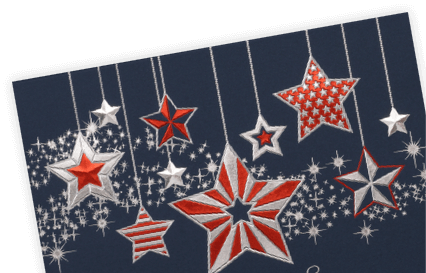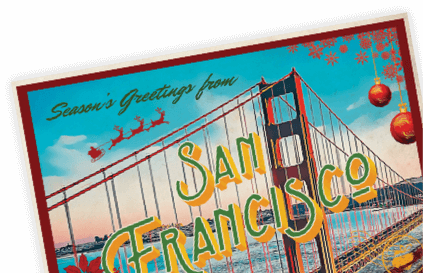Oct 26th 2023
Who Buys Business Greeting Cards?
Business greeting cards play a significant role in building and maintaining relationships with clients, partners, and employees. These thoughtful tokens can instantly convey appreciation, congratulations, or well-wishes that leave a lasting impression and strengthen bonds. From customized holiday cards to thank you notes, there's a wide variety of greeting cards available to cater to diverse business needs.

We understand that it might be difficult to determine who exactly purchases these business greeting cards. The usual buyers include corporations, small businesses, and individual professionals seeking a personal touch in their business interactions.
By incorporating greeting cards into their communication strategies, these entities can establish a memorable connection that goes beyond virtual or distant interactions.
In addition to companies and entrepreneurs, institutions such as non-profit organizations, educational establishments, and government agencies can also benefit from using business greeting cards.
Sending a card is a timeless gesture that demonstrates genuine care, enhances a brand's reputation, and fosters a sense of community across various sectors. Regardless of the industry, a personalized card can make all the difference in maintaining and nurturing important relationships.
Understanding the Market

We have observed that the market of business greeting cards is quite diverse and caters to various needs of both individuals and organizations. The greeting card industry has revenue of around $23 billion globally, with America being one of the major consumers. Various occasions such as Christmas, weddings, and graduations are celebrated through the exchange of these cards.
Most Popular Occasions
Different types of greeting cards are popular in the market, with seasonal greeting cards, stationery, and special occasion cards being at the top of the list. Christmas, in particular, accounts for a substantial portion of sales in America. Apart from this, there are many other celebrations and special occasions, such as weddings, graduations, and birthdays, that continue to drive demand in the greeting card market.
Industry Trends
The greeting card industry evolves constantly to stay ahead of emerging trends and changing consumer preferences. Digital and personalized cards have gained popularity in recent years, as consumers look for more unique and customizable options to express their sentiments. Customization not only allows for a personal touch but also fosters a sense of connection between the sender and the receiver.
One of the emerging trends in the greeting card market is the growing focus on sustainability. Eco-friendly materials and production processes are being implemented by key players in the industry to cater to the increasing environmental concerns of consumers.
Business Greeting Cards
Sending business greeting cards offers organizations a unique opportunity to connect with their clients, customers, and partners on a personal level. These cards help in fostering goodwill, promoting brand visibility, and maintaining strong business relationships. Various business greeting cards can be tailored to suit specific occasions such as holidays, milestones, or achievements, which enables companies to express their gratitude and appreciation more effectively.
Overall, understanding the market for business greeting cards involves being aware of the demographics, popular occasions, industry trends, and potential avenues for growth. By keeping an eye on these factors, businesses and organizations can make informed decisions regarding their greeting card investments and strengthen their relationships with their audience.
Who Are the Buyers

When it comes to business greeting cards, there is a diverse range of buyers with different preferences and needs. Let's explore these various buyer groups to better understand their motivations and interests.
Millennials, a generation born between the early 1980s and mid-1990s, are known for their appreciation of personalized, unique, and eco-friendly products. Many of them are drawn to business greeting cards that reflect their values and stand out from the crowd. They are likely to seek out cards designed by independent artists or printed on sustainable materials.
On the other hand, baby boomers, born between 1946 and 1964, tend to opt for traditional and timeless designs when it comes to business greeting cards. They value quality and thoughtful messages, so they might be inclined to invest in premium, well-crafted cards for their professional relationships.
Households, in general, make up a significant portion of card buyers. Business greeting cards are often exchanged during holidays, special occasions, or as a way to maintain connections with clients, colleagues, and employees. Within households, there could be a designated person responsible for purchasing and sending these cards, whether it's a spouse, parent, or older sibling.
Understanding the target audience for business greeting cards is crucial for catering to their needs and preferences. Each group might prioritize different aspects, be it the design, the message, or the material of the cards. As designers and sellers of business greeting cards, we must be in tune with these various groups to create relevant, appealing products that resonate with them.
Moreover, we can use this knowledge to tailor our marketing efforts, focusing on the specific characteristics and desires of each audience. By doing so, we strengthen our position in the market and nurture lasting relationships with our customers.
Online Vs Offline Sales

As we dive into the world of business greeting cards, it's important to understand the distinction between online and offline sales. The modern shopping landscape offers various opportunities for consumers to purchase greeting cards, whether through an eCommerce platform like an online store or by visiting a local brick-and-mortar storefront.
In recent years, the popularity of online greeting card sales has significantly increased. In 2023, the market size of the online greeting card sales industry was valued at $2.6 billion, showing a 1.36% growth from 2022. Ecommerce platforms, such as Shopify, have facilitated the establishment of online greeting card businesses, enabling entrepreneurs to easily create and customize their digital storefronts.
However, despite the growth in online sales, many people still prefer the tangible experience offered by local, physical stores. Shopping at a brick-and-mortar store allows customers to physically examine the cardstock, design, and overall quality of the greeting cards before making a purchase. In addition, local stores typically offer a personalized touch and the ability to support small businesses within their community.
Comparatively, online sales provide consumers with the convenience of shopping from the comfort of their homes. With the power of Google, finding the perfect business greeting card has become effortless, opening up a plethora of choices and designs suited to individual tastes. Moreover, online card businesses often provide customizable options, allowing customers to add personal messages, images, or company logos.
Taking all of this into account, both online and offline sales avenues continue to coexist in the realm of business greeting cards. While the convenience and variety of online platforms may appeal to some, there remains a loyal customer base that appreciates the physical shopping experience and personalized service offered by local storefronts. Ultimately, the choice between online and offline sales depends on each individual's preferences and the specific needs of their business.
Design and Manufacturing

When it comes to the design and manufacturing process for business greeting cards, there are a few steps we need to consider. Initially, it all starts with the creative artwork that becomes the foundation for the card's design. Talented artists and graphic designers play an essential role in creating eye-catching and meaningful designs tailored to various occasions and business needs.
In many cases, these designs can be completely handmade, giving the cards a unique and personal touch. Handmade cards often incorporate intricate details, textures, and materials that differentiate them from mass-printed options. As a result, these handmade cards can appeal to more discerning buyers who value originality and craftsmanship.
Once the artwork and designs are finalized, it's time to move on to the printing process. In this phase, we carefully select the most suitable printing method to ensure high-quality outcomes, taking into account factors such as color reproduction, material types, and even environmental impact. Some popular printing methods for greeting cards include offset, digital, and letterpress printing, each with its own set of advantages and drawbacks.
As part of the manufacturing process, we also prioritize choosing the right materials for our greeting cards. This includes selecting high-quality paper stocks for durability and visually appealing textures. Additionally, the choice of envelopes and packaging materials adds a finishing touch that can elevate the overall experience for the receiver.
In essence, designing and manufacturing business greeting cards involve a balance between creativity, technical skills, and attention to detail. By combining unique artwork, high-quality materials, and efficient production processes, we can create memorable greeting cards that exceed the expectations of our customers, ultimately making a lasting impression.
E-Cards and Traditional Cards
In today's fast-paced world, we've seen a shift in how people communicate and express gratitude. More and more businesses are opting for e-cards to convey their messages. E-cards offer numerous benefits, such as convenience, cost-effectiveness, and instant delivery. Additionally, e-cards have become increasingly popular due to environmental concerns, as they don't produce paper waste.
However, traditional cards still hold a special place in the hearts of many. Snail mail continues to be a popular option for businesses and individuals who prefer a more personal touch. Traditional cards deliver a tangible connection that represents the time, effort, and thoughtfulness behind the sender's message. This sentiment is difficult to replicate with e-cards.
In the business world, sending both e-cards and traditional cards can cater to the preferences of different clients or employees. With e-cards, it's easy to send an eye-catching design, an animated message, or even a customized video greeting, which can quickly reach the recipient and brighten their day. On the other hand, traditional cards offer the opportunity for a handwritten note or a signature, creating a lasting impression that speaks volumes about the sender's care and attention.
Despite the rising popularity of e-cards, many businesses still value the appeal of traditional cards, often sending a mix of both to cater to the varied preferences of their clientele. Ultimately, it's essential to understand the needs and desires of the recipient when choosing between e-cards and traditional cards, selecting the most fitting option to communicate genuine care and appreciation.
Specialty and Niche Cards

At times, people look for something unique and witty in their greeting cards. This is especially true when it comes to niche and custom greeting cards. These types of cards cater to specific interests and preferences, allowing for a more personalized experience. As creators of such cards, we understand the importance of offering a diverse range of designs and messages to match our clients' tastes and requirements.
Cards like these have gained traction, particularly in the business world. Companies are constantly searching for ways to create meaningful connections with their clients and employees. Incorporating witty and niche cards into their holiday and Christmas greetings helps foster these connections, making a lasting impression that goes beyond the tangible card itself.
Further, sending occupation specific greeting cards are a great way to show pride in your work or connect with your client base.
As we create specialty greeting cards, we pay close attention to the designs, language, and overall tone of the card to ensure that it captures the intended spirit. By offering a wide range of options, from playful and cheeky to heartfelt and sincere, we allow our customers to find the perfect card for their needs. Balancing perplexity and burst, we ensure that our content is both engaging and accessible, appealing to a variety of preferences.
In the world of greeting cards, catering to niche interests and providing witty messages can truly make a difference. Custom and specialty cards not only allow the sender to express their individuality but also leave a lasting impression on the recipient. In all, our goal is to create memorable experiences through the cards we design, fostering connections and spreading joy.


 Business
Business
 Personalized
Personalized
 Holiday
Holiday
 Customer
Customer
 Bulk
Bulk
 Birthday
Birthday
 Thank You
Thank You
 Anniversary
Anniversary
 Sympathy
Sympathy
 Retirement
Retirement
 Christmas
Christmas
 Thanksgiving
Thanksgiving
 New Year
New Year
 Hanukkah
Hanukkah
 Rosh Hashanah
Rosh Hashanah
 Appreciation
Appreciation Merry Christmas
Merry Christmas Happy Holidays
Happy Holidays Seasons Greetings
Seasons Greetings Funny Cards
Funny Cards Religious
Religious Peace
Peace Patriotic
Patriotic Accounting
Accounting Finance
Finance Photo Cards
Photo Cards Foil Cards
Foil Cards Laser Cut Cards
Laser Cut Cards Die Cut Cards
Die Cut Cards Front Imprint
Front Imprint Recycled Cards
Recycled Cards New York
New York San Francisco
San Francisco Chicago
Chicago Los Angeles
Los Angeles Houston
Houston By Animal
By Animal Christmas Tree
Christmas Tree Western/Southwestern
Western/Southwestern Tropical/Beach
Tropical/Beach Winter Scenes
Winter Scenes Budget Cards
Budget Cards Legal
Legal Construction
Construction Real Estate
Real Estate Trucking
Trucking Accounting
Accounting Holiday Phrases
Holiday Phrases







 Fully Custom
Fully Custom  Friendly
Friendly A portion of every card purchased is donated to charity.
A portion of every card purchased is donated to charity.
 Proudly Made
Proudly Made